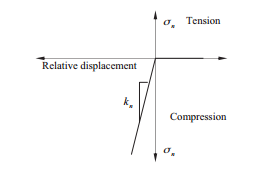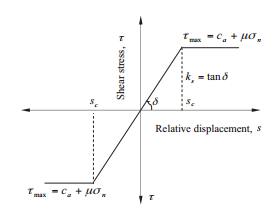WayneKagawa
Structural
I am trying to model the slip and separation between a Nuclear reactor and soil when hit by a bi-directional earthquake using the interaction feature.
The interaction that I am trying to model is as follows:
Normal - Stiffness acts only when the surfaces are in compression and there is no transfer of forces between the surfaces when they are in tension. The paper I am referring to uses a stiffness value of 6.4x10^9 N/m3 of the normal stress vs relative displacement graph as the normal stiffness. I used a HARD contact with PENALTY stiffness feature to model this part. The referred graph is shown below.

Tangential - The two surfaces have a coefficient of friction of 0.7 between them and they slip as soon as the critical load is reached. The reference value of the stiffness of the Stress vs Slip graph is 7x10^9 N/m3. I used the PENALTY method and just gave the coefficient of friction as 0.7.

The details of the model is as follows:
It is a 2D model with the reactor as plain stress model and the soil as plane strain.

The Reactor is much stiffer (E = 1013 N/m2) as compared to the soil (E = 18.72 x108 N/m2).
The boundary conditions are as follows-
Sides -> Free in Vertical direction, Fixed in Horizontal direction.
Base -> Fixed for all DOFs. The acc time histories are applied at the base.
The problems and questions I have are-
1. The value of Normal stiffness that I should use should be in the units N/m because that is what ABAQUS accepts. To get that, should I multiply the given value by the area of the base of the reactor? Or is there another way to get that?
2. I am confused with regard to the shear stress limit option in the Tangential behaviour interaction feature. I tested my contact by applying an incremental load which went a little beyond the theoretical slip load and it did behave correctly by slipping at a value 2% higher than the theo load. However, when I apply the earthquake, it sticks to the surface most of the time and doesn't slip in the required way. That makes me lose faith in my contact. Should I enter a value in the shear stress limit option?
3. The shear stiffness value that the paper mentions. I don't know how to implement that into the program. I tried by dividing the stiffness value by the shear stress at which the slip begins (0.7*max normal stress) to obtain the maximum elastic slip value used in the penalty method but that was just intuition. I don't know if I am correct or not because the slip when earthquake is applied doesn't change at all as mentioned in point 2.
4. The separation between the two surfaces wrt time also doesn't happen as the two surfaces are stuck for the entire duration of the earthquake. I have checked on 'Allow separation after contact' option but that doesn't seem to have any effect on the results.
Is there another way to model this type of contact in abaqus? I thought about connectors but they don't seem to have a NO TENSION option in Axial behaviour.
The interaction that I am trying to model is as follows:
Normal - Stiffness acts only when the surfaces are in compression and there is no transfer of forces between the surfaces when they are in tension. The paper I am referring to uses a stiffness value of 6.4x10^9 N/m3 of the normal stress vs relative displacement graph as the normal stiffness. I used a HARD contact with PENALTY stiffness feature to model this part. The referred graph is shown below.

Tangential - The two surfaces have a coefficient of friction of 0.7 between them and they slip as soon as the critical load is reached. The reference value of the stiffness of the Stress vs Slip graph is 7x10^9 N/m3. I used the PENALTY method and just gave the coefficient of friction as 0.7.

The details of the model is as follows:
It is a 2D model with the reactor as plain stress model and the soil as plane strain.

The Reactor is much stiffer (E = 1013 N/m2) as compared to the soil (E = 18.72 x108 N/m2).
The boundary conditions are as follows-
Sides -> Free in Vertical direction, Fixed in Horizontal direction.
Base -> Fixed for all DOFs. The acc time histories are applied at the base.
The problems and questions I have are-
1. The value of Normal stiffness that I should use should be in the units N/m because that is what ABAQUS accepts. To get that, should I multiply the given value by the area of the base of the reactor? Or is there another way to get that?
2. I am confused with regard to the shear stress limit option in the Tangential behaviour interaction feature. I tested my contact by applying an incremental load which went a little beyond the theoretical slip load and it did behave correctly by slipping at a value 2% higher than the theo load. However, when I apply the earthquake, it sticks to the surface most of the time and doesn't slip in the required way. That makes me lose faith in my contact. Should I enter a value in the shear stress limit option?
3. The shear stiffness value that the paper mentions. I don't know how to implement that into the program. I tried by dividing the stiffness value by the shear stress at which the slip begins (0.7*max normal stress) to obtain the maximum elastic slip value used in the penalty method but that was just intuition. I don't know if I am correct or not because the slip when earthquake is applied doesn't change at all as mentioned in point 2.
4. The separation between the two surfaces wrt time also doesn't happen as the two surfaces are stuck for the entire duration of the earthquake. I have checked on 'Allow separation after contact' option but that doesn't seem to have any effect on the results.
Is there another way to model this type of contact in abaqus? I thought about connectors but they don't seem to have a NO TENSION option in Axial behaviour.
